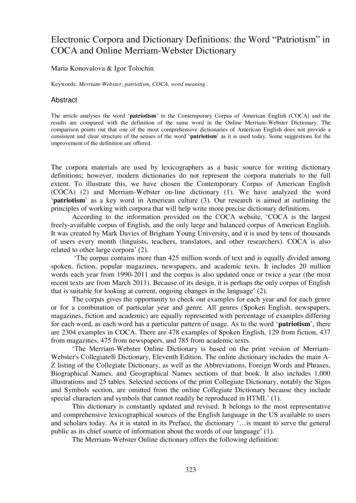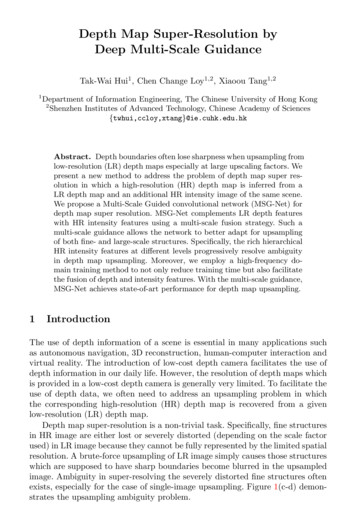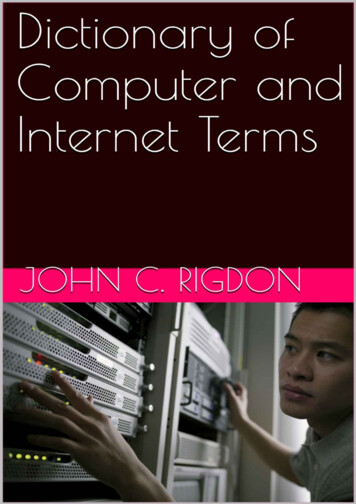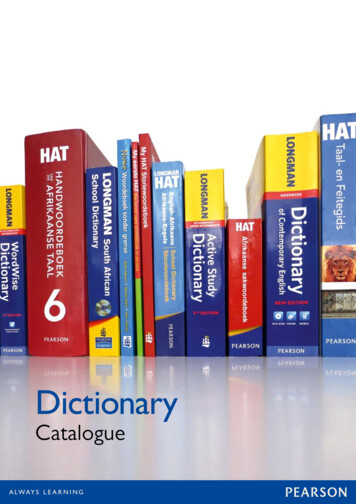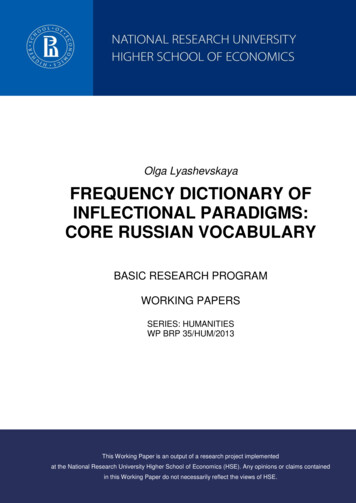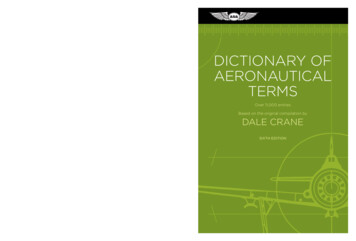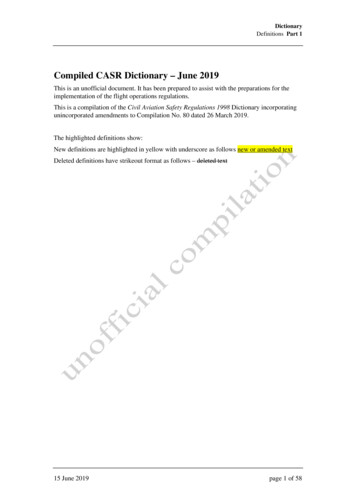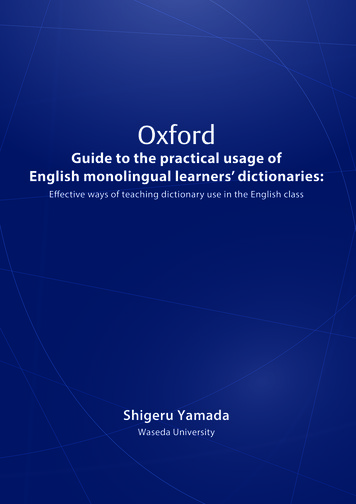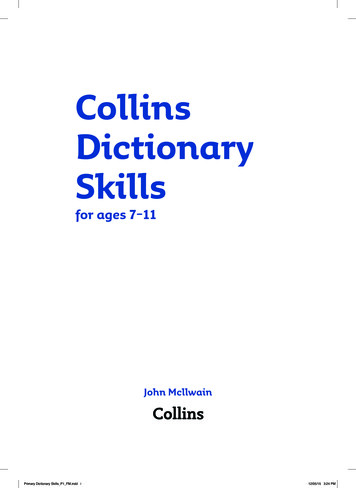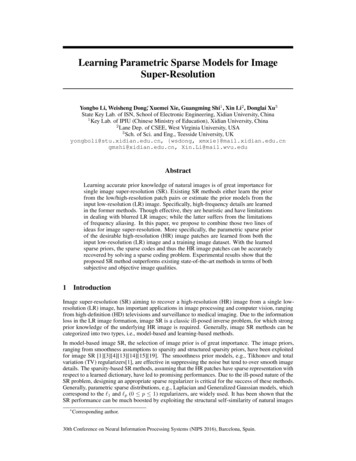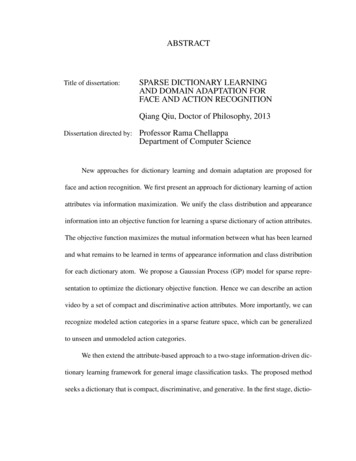
Transcription
ABSTRACTTitle of dissertation:SPARSE DICTIONARY LEARNINGAND DOMAIN ADAPTATION FORFACE AND ACTION RECOGNITIONQiang Qiu, Doctor of Philosophy, 2013Dissertation directed by: Professor Rama ChellappaDepartment of Computer ScienceNew approaches for dictionary learning and domain adaptation are proposed forface and action recognition. We first present an approach for dictionary learning of actionattributes via information maximization. We unify the class distribution and appearanceinformation into an objective function for learning a sparse dictionary of action attributes.The objective function maximizes the mutual information between what has been learnedand what remains to be learned in terms of appearance information and class distributionfor each dictionary atom. We propose a Gaussian Process (GP) model for sparse representation to optimize the dictionary objective function. Hence we can describe an actionvideo by a set of compact and discriminative action attributes. More importantly, we canrecognize modeled action categories in a sparse feature space, which can be generalizedto unseen and unmodeled action categories.We then extend the attribute-based approach to a two-stage information-driven dictionary learning framework for general image classification tasks. The proposed methodseeks a dictionary that is compact, discriminative, and generative. In the first stage, dictio-
nary atoms are selected from an initial dictionary by maximizing the mutual informationmeasure on dictionary compactness, discrimination and reconstruction. In the secondstage, the selected dictionary atoms are updated for improved reconstructive and discriminative power using a simple gradient ascent algorithm on mutual information.When designing dictionaries, training and testing domains may often be different,due to different view points and illumination conditions. We further present a domainadaptive dictionary learning framework for the task of transforming a dictionary learnedfrom one visual domain to the other, while maintaining a domain-invariant sparse representation of a signal. Domain dictionaries are modeled by a linear or non-linear parametric function. The dictionary function parameters and domain-invariant sparse codes arethen jointly learned by solving an optimization problem.Finally, in the context of face recognition, we present a dictionary learning approachto compensate for the transformation of faces due to changes in view point, illumination,resolution, etc. The approach is to first learn a domain base dictionary, and then describeeach domain shift (identity, pose, illumination) using a sparse representation over the basedictionary. The dictionary adapted to each domain is expressed as sparse linear combinations of the base dictionary. With the proposed compositional dictionary approach, aface image can be decomposed into sparse representations for a given subject, pose andillumination respectively. The extracted sparse representation for a subject is consistentacross domains and enables pose and illumination insensitive face recognition. Sparserepresentations for pose and illumination can be used to estimate the pose and illumination condition of a face image. By composing sparse representations for subjects anddomains, we can also perform pose alignment and illumination normalization.
SPARSE DICTIONARY LEARNING AND DOMAIN ADAPTATIONFOR FACE AND ACTION RECOGNITIONbyQiang QiuDissertation submitted to the Faculty of the Graduate School of theUniversity of Maryland, College Park in partial fulfillmentof the requirements for the degree ofDoctor of Philosophy2013Advisory Committee:Professor Rama Chellappa, Chair/AdvisorProfessor John BenedettoProfessor Larry DavisProfessor Amol DeshpandeProfessor Amitabh Varshney
c Copyright byQiang Qiu2013
DedicationTo my family.ii
AcknowledgmentsFirst and foremost I would like to thank my advisor, Professor Rama Chellappa foraccepting me as his student, and supporting me to work on this challenging and interesting topic over the past three years. He has always made himself available whenever Isought his advices. The discussions with him were always encouraging and inspiring. Hisdedication to work, positive attitude towards life, and polite personality will all remain aninspiration for me in my future career.I would like to thank Professor Amol Deshpande for mentoring me in the first twoyears of my PhD study, and serving on both my proposal and dissertation committee. Ithas been a precious experience to work with and learn from him. I would like to also thankProfessor Larry Davis for valuable guidance on research projects and thesis. Thanks aredue to Professor John Benedetto and Professor Amitabh Varshney for agreeing to serve onmy dissertation committee and for sparing their invaluable time reviewing the manuscript.My graduate life has been enriched in many ways by fellow colleagues at the Computer Vision Lab, among whom I should particularly mention Juncheng Chen, Ming Du,Qi Hu, Zhuolin Jiang, Mingyu Liu, Jie Ni, Vishal Patel, Sima Taheri and Pavan Turagafor their fruitful discussion and collaboration on research projects. I would also like toacknowledge administrative help from Ms. Janice Perrone.I owe my deepest thanks to Zhengyi. This work will be impossible without you.It is impossible to remember all, and I apologize to those I’ve inadvertently left out.iii
Table of ContentsList of Figures123viiIntroduction1.1 Sparse Dictionary-based Attributes Learning . . . . .1.2 Information-theoretic Dictionary Learning . . . . . .1.3 Domain Adaptive Dictionary Learning . . . . . . . .1.4 Domain Adaptive Compositional Dictionary Learning1.5 Organization of the Dissertation . . . . . . . . . . .122345Dictionary-based Attributes for Action Recognition and Summarization2.1 Introduction . . . . . . . . . . . . . . . . . . . . . . . . . . . . .2.2 Action Features and Attributes . . . . . . . . . . . . . . . . . . .2.2.1 Basic Features . . . . . . . . . . . . . . . . . . . . . . .2.2.2 Human Action Attributes . . . . . . . . . . . . . . . . . .2.3 A Probabilistic Model for Sparse Representation . . . . . . . . .2.3.1 Reconstructive Dictionary Learning . . . . . . . . . . . .2.3.2 A Gaussian Process . . . . . . . . . . . . . . . . . . . . .2.3.3 Dictionary Class Distribution . . . . . . . . . . . . . . .2.4 Learning Attribute Dictionary . . . . . . . . . . . . . . . . . . .2.4.1 MMI for Unsupervised Learning (MMI-1) . . . . . . . . .2.4.2 MMI for Supervised Learning (MMI-2) . . . . . . . . . .2.4.3 MMI using dictionary class distribution (MMI-3) . . . . .2.5 Action Summarization using MMI-1 . . . . . . . . . . . . . . . .2.6 Experimental Evaluation . . . . . . . . . . . . . . . . . . . . . .2.6.1 Comparison with Alternative Approaches . . . . . . . . .2.6.1.1 Dictionary Purity and Compactness . . . . . . .2.6.1.2 Describing Unknown Actions . . . . . . . . . .2.6.1.3 Recognition Accuracy . . . . . . . . . . . . . .2.6.2 Discriminability of Learned Action Attributes . . . . . . .2.6.2.1 Recognizing Unknown Actions . . . . . . . . .2.6.2.2 Recognizing Realistic Actions . . . . . . . . .2.6.3 Attribute dictionary on high-level features . . . . . . . . .2.6.4 Action Sampling/Summarization using MMI-1 . . . . . .2.7 Conclusion . . . . . . . . . . . . . . . . . . . . . . . . . . . . nformation-theoretic Dictionary Learning3.1 Introduction . . . . . . . . . . . . . . . . . . . . . . . . .3.2 Background and Problem Formulation . . . . . . . . . . .3.3 Information-theoretic Dictionary Learning . . . . . . . . .3.3.1 Dictionary Selection . . . . . . . . . . . . . . . .3.3.1.1 Dictionary compactness I(D ; Do \D ) .3.3.1.2 Dictionary Discrimination I(XD ; C) . .37374042424343iv.
3.43.5453.3.1.3 Dictionary Representation I(Y; D ) . . . . .3.3.1.4 Selection of λ1 , λ2 and λ3 . . . . . . . . . . .3.3.2 Dictionary Update . . . . . . . . . . . . . . . . . . . .3.3.2.1 A Differentiable Objective Function . . . . .3.3.2.2 Gradient Ascent Update . . . . . . . . . . . .3.3.3 Dictionary Learning Framework . . . . . . . . . . . . .Experimental Evaluation . . . . . . . . . . . . . . . . . . . . .3.4.1 Evaluation with Illustrative Examples . . . . . . . . . .3.4.1.1 Comparing Atom Selection Methods . . . . .3.4.1.2 Enhanced Discriminability with Atom Update3.4.1.3 Enhanced Reconstruction with Atom Update .3.4.2 Discriminability of ITDL Dictionaries . . . . . . . . . .Conclusion . . . . . . . . . . . . . . . . . . . . . . . . . . . .Domain Adaptive Dictionary Learning4.1 Introduction . . . . . . . . . . . . . . . . . . . . . .4.2 Overall Approach . . . . . . . . . . . . . . . . . . .4.2.1 Problem Formulation . . . . . . . . . . . . .4.2.2 Domain Dictionary Function Learning . . . .4.2.3 Non-linear Dictionary Function Models . . .4.2.3.1 Linearizeable Models . . . . . . .4.2.4 Domain Parameter Estimation . . . . . . . .4.3 Experimental Evaluation . . . . . . . . . . . . . . .4.3.1 Dictionary Functions for Pose alignment . .4.3.1.1 Frontal Face Alignment . . . . . .4.3.1.2 Pose Synthesis . . . . . . . . . . .4.3.1.3 Linear vs. Non-linear . . . . . . .4.3.2 Dictionary Functions for Classification . . .4.3.3 Dictionary Functions for Domain Estimation4.3.3.1 Pose Estimation . . . . . . . . . .4.3.3.2 Illumination Estimation . . . . . .4.4 Conclusion . . . . . . . . . . . . . . . . . . . . . .Compositional Dictionaries for Domain Adaptive Face Recognition5.1 Introduction . . . . . . . . . . . . . . . . . . . . . . . . . . .5.2 Background . . . . . . . . . . . . . . . . . . . . . . . . . . .5.2.1 Sparse Decomposition . . . . . . . . . . . . . . . . .5.2.2 Multilinear Image Analysis . . . . . . . . . . . . . . .5.3 Problem Formulation . . . . . . . . . . . . . . . . . . . . . .5.4 Domain Adaptive Dictionary Learning . . . . . . . . . . . . .5.4.1 Equivalence of Six Forms . . . . . . . . . . . . . . .5.4.2 Domain Invariant Sparse Coding . . . . . . . . . . . .5.5 Experimental Evaluation . . . . . . . . . . . . . . . . . . . .5.5.1 Learned Domain Base Dictionaries . . . . . . . . . .5.5.2 Domain Composition . . . . . . . . . . . . . . . . . 7678798082828485.87879090929497979899100101
5.665.5.2.1 Pose Alignment . . . . . . . . . . . . . . .5.5.2.2 Illumination Normalization . . . . . . . . .5.5.3 Pose and Illumination Invariant Face Recognition . . .5.5.3.1 Classifying PIE 68 Faces using D4 and D105.5.3.2 Classifying Extended YaleB using D32 . . .5.5.4 Pose and Illumination Estimation . . . . . . . . . . .5.5.5 Mean Code and Error Analysis . . . . . . . . . . . . .Conclusion . . . . . . . . . . . . . . . . . . . . . . . . . . .Directions for Future Work6.1 Unsupervised Domain Adaptive Dictionary Learning .6.1.1 Initial Considerations on Unsupervised DADL6.2 Structure-Preserved Sparse Decomposition for Actions6.3 Alignment Invariant Sparse Representation . . . . . 3127128vi
List of Figures2.12.22.32.42.52.62.72.82.9Sparse representations of four actions (two are known and two are unknown to the attribute dictionary) using attribute dictionaries learned bydifferent methods. Each action is performed by two different humans. Forvisualization purpose, each waveform shows the average of the sparsecodes of all frames in an action sequence. We learned several attributedictionaries using methods including our approach, the Maximization ofEntropy approach (ME), the MMI-3 approach motivated by [1] and theK-means approach. A compact and discriminative attribute dictionaryshould encourage actions from the same class to be described by a similar set of attributes, i.e., similar sparse codes. The attribute dictionarylearned by our approach provides similar waveforms, which shows consistent sparse representations, for the same class action sequences. . . . .Purity and compactness of learned dictionary D : purity is the histogramsof the maximum probability observing a class given a dictionary atom,and compactness is the histograms of D T D . At the right-most bin of therespective figures, a discriminative and compact dictionary should exhibithigh purity and small compactness. MMI-2 dictionary is most “pure” andsecond most compact (MMI-1 is most compact but much less pure.) . . .Learned attribute dictionaries on shape features (“unseen” classes: flap,stop both and attention both) . . . . . . . . . . . . . . . . . . . . . . . .Recognition accuracy on the Keck gesture dataset with different featuresand dictionary sizes (shape and motion are global features. STIP [2] is alocal feature.). The recognition accuracy using initial dictionary Do : (a)0.23 (b) 0.42 (c) 0.71 (d) 0.81. In all cases, the proposed MMI-2 (red line)outperforms the rest. . . . . . . . . . . . . . . . . . . . . . . . . . . . .Sample frames from the UCF sports action dataset. The actions include:diving, golfing, kicking, weight-lifting, horse-riding, running, skateboarding, swinging-1 (on the pommel horse and on the floor), swinging-2 (atthe high bar), walking. . . . . . . . . . . . . . . . . . . . . . . . . . . .Confusion matrix for UCF sports dataset . . . . . . . . . . . . . . . . . .Sample frames from the UCF50 action dataset. UCF50 is an action recognition dataset with 50 action categories, consisting of 6617 realistic videostaken from youtube. . . . . . . . . . . . . . . . . . . . . . . . . . . . . .Shape sampling on the MPEG dataset. The proposed MMI-1 method,which enforces both diversity and coverage criteria, retrieved all 10 shapeclasses. . . . . . . . . . . . . . . . . . . . . . . . . . . . . . . . . . . .An MMI-1 action summarization example using the UCF sports dataset .vii72123323333343536
3.13.23.33.43.5Sparse representation using dictionaries learned by different approaches(SOMP [3], MMI-1 and MMI-2 [4]). For visualization, sparsity 3 is chosen, i.e., no more than three dictionary atoms are allowed in each sparsedecomposition. When signals are represented at once as a linear combination of a common set of atoms, sparse coefficients of all the samplesbecome points in the same coordinate space. Different classes are represented by different colors. The recognition accuracy is obtained throughlinear SVMs on the sparse coefficients. Our approach provides more discriminative sparse representation which leads to significantly better classification accuracy. . . . . . . . . . . . . . . . . . . . . . . . . . . . . .Recognition accuracy and RMSE on the YaleB dataset using different dictionary selection methods. We vary the sparsity level, i.e., the maximalnumber of dictionary atoms that are allowed in each sparse decomposition. In (a) and (b), a global set of common atoms are selected for allclasses. In (c) and (d), a dedicated set of atoms are selected per class. Inboth cases, the proposed ITDS (red lines) provides the best recognitionperformance and moderate reconstruction error. . . . . . . . . . . . . . .Information-theoretic dictionary update with global atoms shared overclasses. For a better visual representation, sparsity 2 is chosen and a randomly selected subset of all samples are shown. The recognition rateassociated with (a), (b), and (c) are: 30.63%, 42.34% and 51.35%. Therecognition rate associated with (d), (e), and (f) are: 73.54%, 84.45% and87.75%. Note that the proposed ITDU effectively enhances the discriminability of the set of common atoms. . . . . . . . . . . . . . . . . . . .Information-theoretic dictionary update with dedicated atoms per class.The first four digits in the USPS digit dataset are used. Sparsity 2 is chosen for visualization. In each figure, signals are first represented at once asa linear combination of the dedicated atoms for the class colored by red,then sparse coefficients of all signals are plotted in the same 2-D coordinate space. The proposed ITDU effectively enhances the discriminabilityof the set of dedicated atoms. . . . . . . . . . . . . . . . . . . . . . . .Reconstruction using class dedicated atoms with the proposed dictionaryupdate (sparsity 2 is used.). (a), (b) and (c) show the updated dictionaryatoms, where from the top to the bottom the two atoms in each row arethe dedicated atoms for class ‘1’,‘2’,‘3’ and ‘0’. (e), (f) and (g) showthe reconstruction to (d). (i), (j) and (k) show the reconstruction to (h).(h) are images in (d) with 60% missing pixels. Note that ITDU extractsthe common internal structure of each class and eliminates the variationwithin the class, which leads to more accurate classification. . . . . . . .viii5660616263
4.1Overview of our approach. Consider example dictionaries correspondingto faces at different azimuths. (a) shows a depiction of example dictionaries over a curve on a dictionary manifold which will be discussed later.Given example dictionaries, our approach learns the underlying dictionary function F (θ, W). In (b), the dictionary corresponding to a domainassociated with observations is obtained by evaluating the learned dictionary function at the corresponding domain parameters. . . . . . . . . . .4.2 The vector transpose (VT) operator over dictionaries. . . . . . . . . . . .4.3 The stack P training signals observed in N different domains. . . . . . .4.4 Illustration of exponential maps expm and inverse exponential maps logm[5]. . . . . . . . . . . . . . . . . . . . . . . . . . . . . . . . . . . . . . .4.5 Frontal face alignment. For the first row of source images, pose azimuthsare shown below the camera numbers. Poses highlighted in blue areknown poses to learn a linear dictionary function (m 4), and the remaining are unknown poses. The second and third rows show the aligned faceto each corresponding source image using the linear dictionary functionand Eigenfaces respectively. . . . . . . . . . . . . . . . . . . . . . . . .4.6 Pose synthesis using various degrees of dictionary polynomials. All thesynthesized poses are unknown to learned dictionary functions and associated with no actual observations. m is the degree of a dictionarypolynomial in (4.4). . . . . . . . . . . . . . . . . . . . . . . . . . . . . .4.7 Linear vs. non-linear dictionary functions. m is the degree of a dictionarypolynomial in (4.4) and (4.8) . . . . . . . . . . . . . . . . . . . . . . . .4.8 Face recognition accuracy on the CMU PIE dataset. The proposed methodis denoted as DFL in color red. . . . . . . . . . . . . . . . . . . . . . . .4.9 Pose azimuth estimation histogram (known subjects). Azimuths estimatedusing the proposed dictionary functions (red) spread around the true values (black). . . . . . . . . . . . . . . . . . . . . . . . . . . . . . . . . .4.10 Pose azimuth estimation histogram (unknown subjects). Azimuths estimated using the proposed dictionary functions (red) spread around thetrue values (black). . . . . . . . . . . . . . . . . . . . . . . . . . . . . .4.11 Illumination estimation in the Extended YaleB face dataset. . . . . . . . .5.15.25.3Trilinear sparse decomposition. Given a domain base dictionary, an unknown face image is decomposed into sparse representations for eachsubject, pose and illumination respectively. The domain-invariant subject (sparse) codes are used for pose and illumination insensitive facerecognition. The pose and illumination codes are also used to estimatethe pose and lighting condition of a given face. Composing subject codeswith corresponding domain codes enables pose alignment and illumination normalization. . . . . . . . . . . . . . . . . . . . . . . . . . . . . .An N -mode SVD (N 3 is illustrated) [6]. . . . . . . . . . . . . . . . . .Six forms of arranging face images of K subjects in J poses under Lillumination conditions. Each square denotes a face image in a columnvector form. . . . . . . . . . . . . . . . . . . . . . . . . . . . . . . . . .ix6671747477788081828384889395
5.45.55.65.75.85.95.105.115.125.13Pose and illumination variation in the PIE dataset. . . . . . . . . . . . . . 100Pose alignment through domain composition. In each corresponding Tensorfaces experiment, we adopt the same training data and sparsity valuesused for the DADL base dictionary for a fair comparison. When a subjector a pose is unknown to the training data, the proposed DADL methodprovides significantly more accurate reconstruction to the ground truthimages. . . . . . . . . . . . . . . . . . . . . . . . . . . . . . . . . . . . 111Illumination normalization through domain composition. In each corresponding Tensorfaces experiment, we adopt the same training data andsparsity values used for the DADL base dictionary for a fair comparison. When a subject is unknown to the training data, the proposed DADLmethod provides significantly more accurate reconstruction to the groundtruth images. . . . . . . . . . . . . . . . . . . . . . . . . . . . . . . . . 112Face recognition under combined pose and illumination variations for theCMU PIE dataset. Given three testing poses, Frontal (c27), Side (c05),Profile (c22), we show the percentage of correct recognition for each disjoint pair of Gallery-Probe poses. See Fig. 5.4 for poses and lightingconditions. Methods compared here include Tensorface [6, 7], SMD [8]and our domain adaptive dictionary learning (DADL) method . DADL-4uses the dictionary D4 and DADL-10 uses D10 . To the best of our knowledge, SMD reports the best recognition performance in such experimentalsetup. 4 out of 6 Gallery-Probe pose pairs, i.e., (a), (b), (d) and (e), ourresults are comparable to SMD. . . . . . . . . . . . . . . . . . . . . . . . 113Illumination variation in the Extended YaleB dataset. . . . . . . . . . . . 113Illumination and pose estimation on the CMU PIE dataset using base dictionaries D4 and D10 . Average accuracy: (a) 0.63, (b) 0.58, (c) 0.28,(d) 0.98, (e) 0.83, (f) 0.78. The proposed DADL method exhibits significantly better domain estimation accuracy than the Tensorfaces method. . 114Mean subject code of subject s1 over 21 illumination conditions in eachof the three testing poses, and standard error of the mean code. (a),(b),(c)are generated using DADL with the base dictionary D10 . (d),(e),(f) aregenerated using Tensorfaces. . . . . . . . . . . . . . . . . . . . . . . . . 115Mean subject code of subject s2 over 21 illumination conditions in eachof the three testing poses, and standard error of the mean code. (a),(b),(c)are generated using DADL with the base dictionary D10 . (d),(e),(f) aregenerated using Tensorfaces. . . . . . . . . . . . . . . . . . . . . . . . . 116Mean illumination code of illumination condition f 1 over 68 subjectsin each of the three testing poses, and standard error of the mean code.(a),(b),(c) are generated using DADL with the base dictionary D10 . (d),(e),(f)are generated using Tensorfaces. . . . . . . . . . . . . . . . . . . . . . . 117Mean pose code of subject s1 over 21 illumination conditions for each ofthe three testing poses, and standard error of the mean code. (a),(b),(c)are generated using DADL with the base dictionary D10 . (d),(e),(f) aregenerated using Tensorfaces. . . . . . . . . . . . . . . . . . . . . . . . . 118x
6.1Given labeled data in the source domain and unlabeled data in the target domain, we propose an iterative dictionary learning procedure to learn a set of intermediate domains. We then generate corresponding intermediate observationsassociated with the intermediate domains. . . . . . . . . . . . . . . . . . . . 1216.26.3Sample frames of a football Hitch play video sequence . . . . . . . . . .Grouping for actions based on common motion. Trajectories at one timeinstant are shown. The resulting groups are of different shapes and colors.The football simple-p51curl play . . . . . . . . . . . . . . . . . . . . . .Effects of misalignments on recognition using sparse representation [9].Top: The input face is from Viola and Jones’ face detector. Bottom: Theinput face is well aligned to the training data. . . . . . . . . . . . . . . .6.46.5xi124124125127
Chapter 1IntroductionDescribing human actions and faces using attributes is closely related to representingan object using attributes [10]. Several studies have investigated the attribute-based approaches for object recognition problems [10–14]. These methods have demonstratedthat attribute-based approaches can not only recognize object categories, but can also describe unknown object categories. In this dissertation, we first present a dictionary-basedapproach for learning human action attributes which are useful to model and recognizeknown action categories, and also describe unknown action categories. We then extendthe action attributes learning approach to an information-theoretic dictionary learningframework for general image classification tasks. When designing dictionaries, we often face the problem that training and testing domains may be different, due to differentview points and illumination conditions. We further propose a domain adaptive dictionarylearning framework for the task of transforming a dictionary learned from one visual domain to the other, while maintaining a domain-invariant sparse representation of a signal.Finally, we discuss a compositional dictionary approach for domain adaptive face recognition. The dictionary adapted to each domain is expressed as sparse linear combinationsof a base dictionary.1
1.1Sparse Dictionary-based Attributes LearningIn the first contribution, we consider dictionary learning of human action attributes throughinformation maximization. In addition to using the appearance information between dictionary atoms, we also exploit the class label information associated with dictionary atomsto learn a compact and discriminative dictionary for human action attributes. The mutualinformation for appearance information and class distributions between the learned dictionary and the rest of the dictionary space are used to define the objective function, which isoptimized using a Gaussian Process (GP) model [15] proposed for sparse representation.The property of sparse coding naturally leads to a GP kernel with compact support resulting in significant speed-ups. The representation and recognition of actions are throughsparse coefficients related to learned attributes. A compact and discriminative attributedictionary should encourage the signals from the same class to have very similar sparserepresentations. In other words, the signals from the same class are described by a similarset of dictionary atoms with similar coefficients, which is critical for classification usinglearned dictionaries. Experimental results on four public action datasets demonstrate theeffectiveness of our approach in action recognition and summarization.1.2Information-theoretic Dictionary LearningIn the second contribution, we extend the action attributes learning approach to a twostage information-theoretic dictionary learning framework for general image classification tasks. A key feature of our framework is that it can learn not only reconstructive butalso compact and discriminative dictionaries. Our method consists of two main stages2
involving greedy atom selection and simple gradient ascent atom updates, resulting in ahighly efficient algorithm. In the first stage, dictionary atoms are selected in a greedy waysuch that the common internal structure of signals belonging to a certain class is extractedwhile simultaneously maintaining global discrimination among the classes. In the secondstage, the dictionary is updated for better discrimination and reconstruction via a simplegradient ascent method that maximizes the mutual information (MI) between the signalsand the dictionary, as well as the sparse coefficients and the class labels. Experimentsusing public object and face datasets demonstrate the effectiveness of our approach forimage classification tasks.1.3Domain Adaptive Dictionary LearningIn the third contribution, we explore a function learning framework for the task of transforming a dictionary learned from one visual domain to the other, while maintaining adomain-invariant sparse representation of a signal. When designing dictionaries for image classification tasks, we are often confronted with situations where conditions, e.g.,view points and illumination, in the training set are different from those present duringtesting. Given the same set of signals observed in different visual domains, our goal is tolearn a dictionary for the new domain without corresponding observations. We formulatethis problem of dictionary transformation in a function learning framework, i.e., dictionaries across different domains are modeled by a parametric function. The dictionaryfunction parameters and domain-invariant sparse codes are then jointly learned by solving an optimization problem. The problem of transforming a dictionary trained from one3
visual domain to another without changing signal sparse representations can be viewedas a problem of domain adaptation [16] and transfer learning [17]. We demonstrate theeffectiveness of our approach for applications such as face recognition, pose alignmentand pose estimation.1.4Domain Adaptive Compositional Dictionary LearningIn the final contribution, we present a compositional dictionary approach for domain adaptive face recognition. Face recognition across domains, e.g., pose and illumination, hasproved to be a challen
Title of dissertation: SPARSE DICTIONARY LEARNING AND DOMAIN ADAPTATION FOR FACE AND ACTION RECOGNITION Qiang Qiu, Doctor of Philosophy, 2013 Dissertation directed by: Professor Rama Chellappa Department of Computer Science New approaches for dictionary learning and domain
